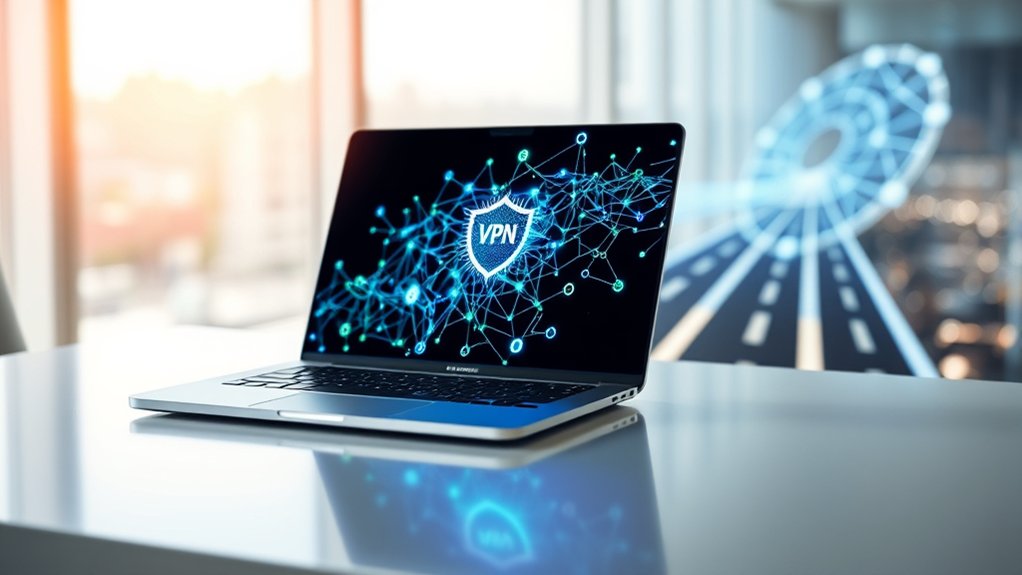Split tunneling is a cybersecurity approach that permits the selective routing of internet traffic through a virtual private network (VPN). This method allows users to simultaneously access corporate resources at the same time as maintaining connectivity to local networks. By dividing network traffic, split tunneling improves bandwidth conservation and reduces potential slowdowns. Nevertheless, security risks can arise if non-VPN traffic exposes sensitive information, necessitating careful configuration. Such complexities in implementation highlight the importance of understanding split tunneling’s operational nuances.

In the domain of cybersecurity, split tunneling represents a significant feature of Virtual Private Networks (VPNs) that allows users to steer select internet traffic through a secure VPN tunnel in addition to permitting other traffic to flow directly to the internet.
This dual approach grants users the ability to access multiple security domains simultaneously, facilitating continuous connectivity to both local and remote resources. By dividing network traffic into secure and non-secure pathways, split tunneling becomes particularly useful for remote workers who need to access corporate resources while maintaining their local internet connectivity.
There are various types of split tunneling, including Split-Include and Split-Exclude tunneling, which define which traffic is routed through the VPN. App-based and URL-based split tunneling takes this a step further, allowing traffic routing depending on specific applications or designated websites. Inverse split tunneling, an alternative concept, allows only certain applications to use the VPN while others access the internet directly. Not all VPNs support split tunneling, and this can limit user options depending on their choice of service provider. Split tunneling is a VPN feature that differentiates internet traffic, enabling users to choose which apps are protected and which ones utilize a regular connection.
Such distinctions improve flexibility, convenience, and user experience.
Improved distinctions enhance user flexibility, streamline convenience, and elevate the overall experience in network traffic management.
Among the notable benefits of split tunneling is its capacity for bandwidth conservation. By restricting VPN traffic to sensitive data, less relevant traffic can bypass VPN encryption, thereby preventing potential slowdowns.
In addition, users can navigate local services while benefiting from the improved security that VPNs offer when needed. Nonetheless, although split tunneling provides significant advantages, it does not come without challenges.
Security risks arise as non-VPN traffic may expose sensitive information to potential threats. Moreover, complex setups may be required for effective configuration, particularly regarding dynamic or application-based settings.
Issues like DNS disruptions can also occur due to improper configurations. In the evolving environment of cybersecurity, split tunneling remains a valuable tool, enabling users to strike a balance between secure data transmission and convenient access to necessary online resources.
Frequently Asked Questions
Is Split Tunneling Secure for Personal Use?
The security of split tunneling for personal use remains a contentious issue among cybersecurity experts.
Although it offers advantages, such as reduced bandwidth consumption and improved speed for non-sensitive traffic, it equally poses significant risks.
Misconfiguration can lead to exposing data to malicious attacks, particularly over unsecured networks.
Experts caution that, without careful management, relying on split tunneling may compromise user privacy, thereby increasing vulnerability to cyber threats in personal settings.
What Are the Risks of Using Split Tunneling?
The risks associated with split tunneling include potential exposure of unencrypted traffic, increasing the likelihood of data breaches.
Organizations may struggle with regulatory compliance, particularly in sensitive sectors like healthcare or finance.
Moreover, lack of visibility complicates network monitoring, making threat detection more challenging.
Experts warn that improper configurations may inadvertently lead to device vulnerabilities, emphasizing the necessity for strong policy enforcement and continuous monitoring to mitigate these security challenges effectively.
Can Split Tunneling Slow Down Internet Speed?
Split tunneling has the potential to improve internet speeds by allowing non-sensitive traffic to bypass the VPN, thereby reducing encryption overhead.
Reports indicate that VPN usage can decrease speeds by up to 50%, depending on various factors such as server load and distance.
How to Enable Split Tunneling on My Device?
To allow split tunneling on a device, users must first access their VPN application settings.
For Windows, one can activate the feature under settings and select specific apps to either bypass or utilize the VPN connection.
On Linux, command-line tools such as `expressvpnctl` command facilitate configuration.
This ability allows users to manage traffic selectively, thereby enhancing network efficiency during maintaining connection to both local and VPN-secured networks.
Is Split Tunneling Recommended for Businesses?
The recommendation for businesses regarding split tunneling is complex.
It offers advantages such as improved network flexibility and bandwidth conservation, which can elevate overall performance.
Nevertheless, concerns persist, particularly regarding security implications. For instance, bypassing gateway-level security may expose sensitive data to threats.
Experts highlight the necessity for clear policies and regular audits to guarantee compliance and mitigate risks.
Ultimately, businesses must weigh operational efficiency against potential vulnerabilities when considering adoption.









